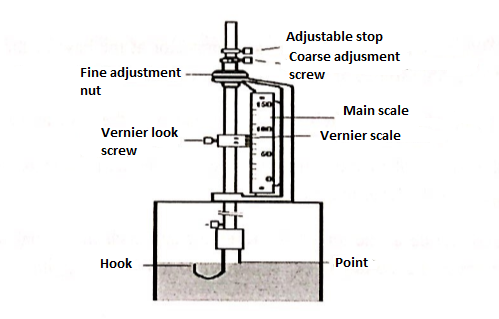utilize Vernier depth gauge, inclined scale and scale, to determine liquids level
Lab 4: Fluid Statics and Manometry Apparatus
Location: UDC, engineering building, C level
Objective:
The objective of this lab is to utilize Vernier depth gauge, inclined scale and scale, to determine liquids level.
Introduction:
The behavior of liquids under certain circumstance of hydrostatics is observed by fluid statics and manometry. Different techniques like linear scale, avoiding parallax, vernier scale, inclined tube and area ratio are utilized.
The following apparatus is used:
Food color (water soluble)
Fluid statics and manometry apparatus (F1-29)
Hydraulics bench (F1-10)
Following procedure is followed:
The f1-29 apparatus is placed on a solid surface to avoid any accidents. Then connect F1-10 is connected to the reservoir’s filling tube from one end and fill the reservoir to 200mm. some kind of color can be added to make the level clearly visible. Linear scale is then used to measure the depth. Eyes are kept at the level of the water and readings are recorded. Now use avoiding parallax method. First keep the eye 100 mm above and then 100 mm down of the water surface. Keep moving the head up and down. It will be observed that the reading vary when the eye is not at the exact level. Record the reading when he eye is at exact level of the water surface.
Vernier scale method used to measure the water level
The following apparatus shown in the image is used

Open the coarse adjustment scale and move the vertical rod up and down. Wait till you achieve the desired level and tight the screw. The reading is recorded whenever the tip of the vertical rod and its shadow coincide. At this time open the screw of the Vernier hook and set the zero point in line with the convenient point. Recording is made at this point. The water can be released with care by opening the base valve of the reservoir. Water level change is recorded by adjusting the height of the Vernier gauge. As a final step, move the fine adjustment nut till the tip of the hook gets exactly to the surface of the water and a recording is made.
The final method – incline tube method.
For this test we hold the right angle. At the same time, pull the indexing knob forwards at angle of 60 degree above the horizontal compared to inclining knob. The knob is then put back to its secure position. The movement of the water is magnified if the distance travelled by water is more than vertical height. Hold the right hand tube while pulling the indexing knob forwards then incline the tube to an angle of 30 above the horizontal and push the knob back to secure position. Now repeat the same procedure as that was done in the first step.
Following are the recordings from the lab
| Liquid level measurement using a level scale liquid level (mm) | Liquid level (mm) | |
| Eye at the liquid level | 200 | |
| Eye 100 mm below the liquid level | 197 | |
| Eye 100 mm above the liquid level | 203 | |
| Liquid level measurement using Vernier scale liquid level (mm) | Liquid level linear (mm) | |
| Point gauge 50mm-39.2mm = 10.8 mm | 200-189=11 | |
| Hook gauge 50mm-44.6mm = 5.4 mm | 189-184=5 | |
| Free surface Demonstration | Liquid level (mm) | Vertical height (mm) |
| At reservoir/ U-tube | 178/176 | 178/176 |
| Fixed tube | 176 | 176 |
| Incline tube 60˚ | 212 | 212*sin(60) = 183.6 |
| Incline tube 30˚ | 420 | 210 |
| Pressure change in the reservoir | Level change in the reservoir/Pressure change ΔP (kN/m2) | Level change in the U-tube/Pressure change ΔP (kN/m2) |
| Apply the pressure | 168 | 325 |
| Reduce the pressure | 185 | 48 |
| Pressure change in the U-tube | Level change in the U-tube/Pressure change ΔP (kN/m2) | Level change in the reservoir/Pressure change ΔP (kN/m2) |
| Connection with the reservoir | 0 | 182 |
| No connection with the reservoir | Left 331 / Right 11 | 177 |
| Pressure changes in the two fixed tubes | Level change in the legs (mm) | Level change in the U-tubes (mm) |
| Apply the pressure | Left 176 / Right 14 | 176 |
| Reduce the pressure | 170/405 | 171 |
Results and conclusion:
From the above procedures and the results, we can safely conclude that inclined tube is the most accurate method of all the methods used. A large number of human errors are possible in linear scale method. The same way the parallax method is also having a much room for human error.




